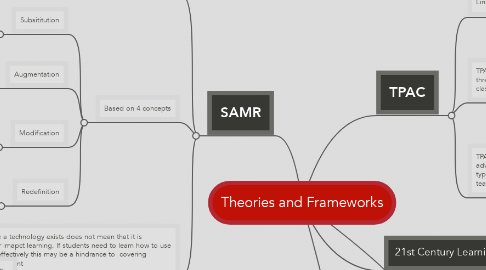
1. My philosophy: What is it?
1.1. Technology should be used where it makes sense and not just because
1.2. It should bring more meaning and engagement to the lesson
1.3. It should fall within student's existing skill sets and not take time away from learning to use the tool
2. SAMR
2.1. Method of measuring how computer technology might impact teaching and learning. Scale of measurement for effectiveness of technology
2.2. Based on 4 concepts
2.2.1. Subsititution
2.2.1.1. Technology just replaces a n assignment that was done before. No Change in teaching and learning.
2.2.2. Augmentation
2.2.2.1. Computer Technology offers an effective tool to perform common tasks. students get feedback faster or become more engaged in activity due to technology
2.2.3. Modification
2.2.3.1. Common classroom tasks are being accomplished through the use of computer technology. Computer technology is necessary for this classroom to function. Grades improve .5 of a mark
2.2.4. Redefinition
2.2.4.1. Computer technology allows for new tasks that were previously unimaginable.At this level, common classroom tasks and computer technology exist not as ends but as supports for student centred learning.
2.3. Just because a technology exists does not mean that it is enhancing or imapct learning. If students need to learn how to use technology effectively this may be a hindrance to covering appropriate content
3. Philosophy of Teachnology
3.1. Comes from beliefs of current teaching practices
3.1.1. Includes belief about how technology should be used
3.1.2. Should be developed with TPAC and SAMR in mind
4. TPAC
4.1. Link to Image of TPAC Model
4.2. TPAC is based on the intersection of three types of knowledge in the classroom
4.2.1. Content Knowledge
4.2.1.1. Knowledge a teacher has of the curriculum
4.2.2. Pedagogical Knowledge
4.2.2.1. Teachers knowledge about how to teach and how students learn
4.2.3. Technologicial Knowledge
4.2.3.1. Knowledge about and experience working with Technology
4.3. TPAC is a model for using technology and advocates a strong understanding of different types of knowledge for effective classroom teaching.
5. 21st Century Learning
5.1. Foundational Knowledge
5.1.1. Content, Information literacy, Cross disciplinary knowledge
5.2. Humanistic Knowledge
5.2.1. Life/Job skills, Cultural competence, Ethical/Emotional awarness
5.3. Meta Knowledge
5.3.1. Problem solving, Critical thinking, Communicaton/Collaboration, Creativity
